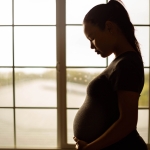
The current American College of Obstetricians and Gynecologists (ACOG) guidelines recommend screening for postpartum mood and anxiety disorders at the first postpartum visit; however ACOG states that as many as 40% of women do not attend a postpartum visit. Several studies suggest that screening earlier in the postpartum period may be helpful in identifying women at higher risk for experiencing postpartum depression. Given that most women stay in the hospital for at least 48 hours after the birth of a child, would it be possible to initiate earlier screening for postpartum depression (PPD), even before the mother leaves the hospital?
Screening at 1 week postpartum: In a population-based sample (Dennis, 2004), 594 mothers completed the EPDS at 1, 4 and 8 weeks postpartum. At 1 week postpartum, 29.5% of mothers scored 10 or higher on the EPDS, decreasing to 23% at 4 weeks and 20.5% at 8 weeks.
Using an EPDS cut-off score of 9/10, the 1-week EPDS accurately classified 85.4% mothers at 4 weeks and 82.5% mothers at 8 weeks with postpartum depression symptoms. More specifically, mothers with a 1-week EPDS score 10 or higher were 30.3 times more likely at 4 weeks (95% CI=17.5-42.3) and 19.1 times more likely at 8 weeks (95% CI=11.0-32.9) to exhibit postpartum depression symptoms.
Screening at 2-3 days postpartum: Teissèdre and colleagues (2004) evaluated a total of 1154 women using the EPDS at 2 to 3 days postpartum and again at 4 to 6 weeks postpartum. Using a cut-off scores of 10/11, the EPDS implemented at 2 to 3 days postpartum obtained good specificity, sensitivity, and positive predictive values for identifying mothers with postpartum depressive symptoms between 4 and 6 weeks postpartum.
Opportunities for Early Detection and Intervention
Mood fluctuations are extremely common during the first postpartum week, with approximately 60%-85% of women reporting mild to moderate mood symptoms or “the blues”. While this may complicate screening, these studies using the EPDS to screen for depressive symptoms within the first postpartum week suggest that there is continuum between more severe mood symptoms immediately after birth and a later diagnosis postpartum depression. While in the United States, we typically screen at the first postpartum visit at 6 weeks, these studies indicate that clinically significant depressive symptoms may emerge long before that first visit and suggest the possibility of screening for postpartum depression before women even leave the hospital.
Considering the significant public health impact of postpartum depression, its well-documented psychological risk factors, and the considerable obstacles to treatment for affected women, prioritizing PPD prevention offers great promise. Multiple studies have explored the use of psychological interventions, such as cognitive behavioral therapy, in women at high risk for PPD to reduce risk for postpartum depression.
Early identification of women with PPD has many benefits and can potentially reduce the impact of maternal depressive symptoms on the child and family. By identifying women at increased risk for PPD immediately after childbirth, we could offer closer monitoring in the following week and possibly introduce interventions that improve outcomes for both the mother and her child.
Ruta Nonacs, MD PhD
References
Dennis CL. Can we identify mothers at risk for postpartum depression in the immediate postpartum period using the Edinburgh Postnatal Depression Scale? J Affect Disord. 2004 Feb; 78(2):163-9.
Teissèdre F, Chabrol H. Detecting women at risk for postnatal depression using the Edinburgh Postnatal Depression Scale at 2 to 3 days postpartum. Can J Psychiatry. 2004 Jan; 49(1):51-4.




